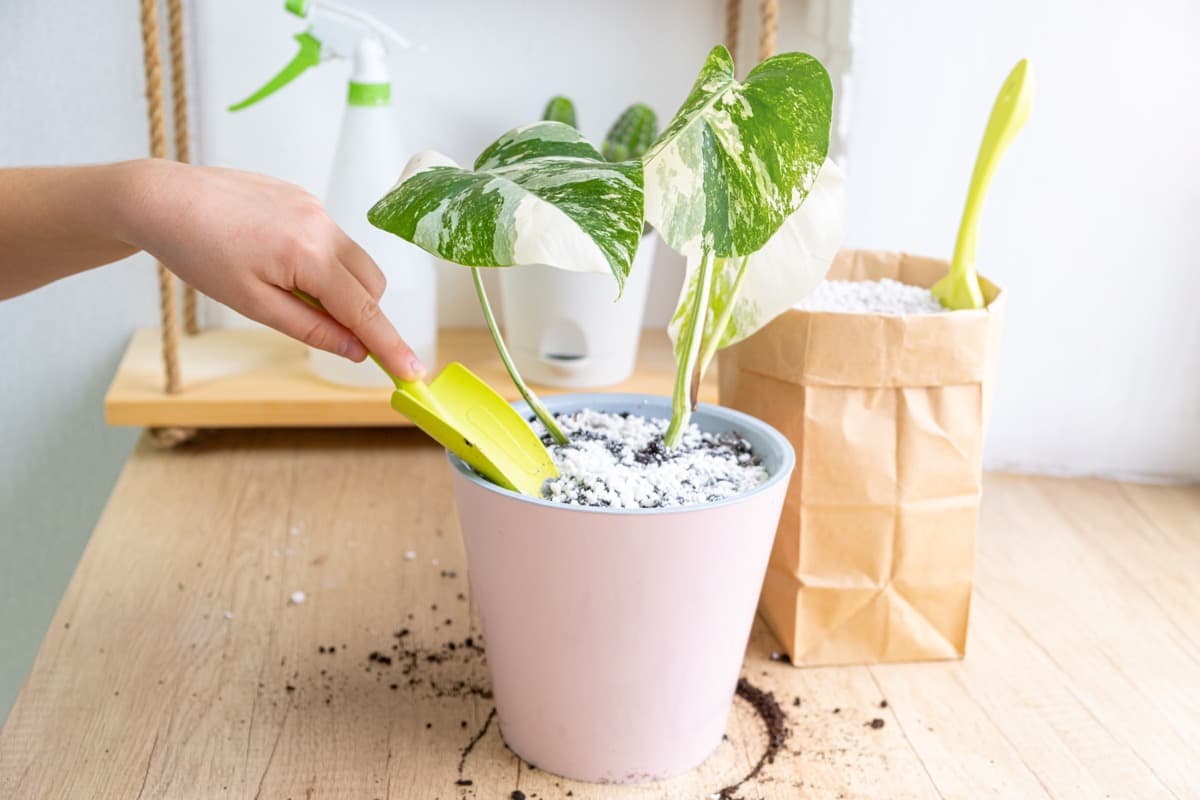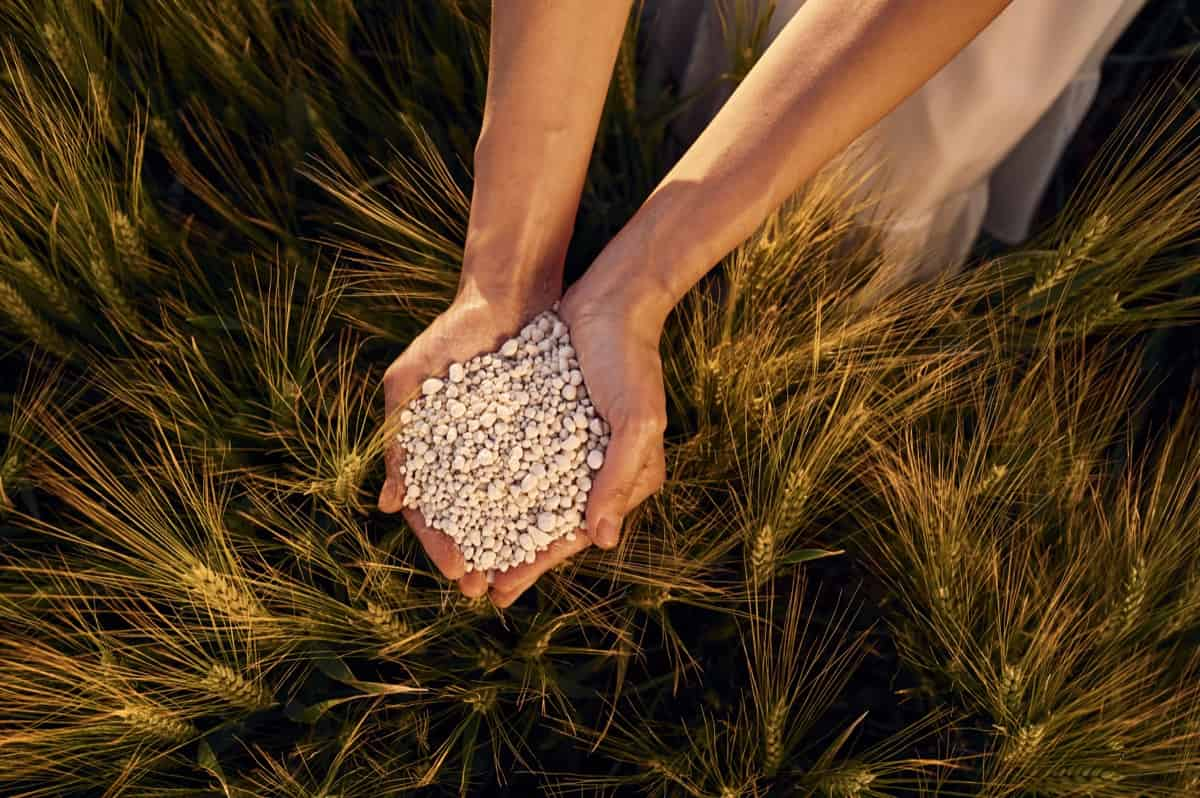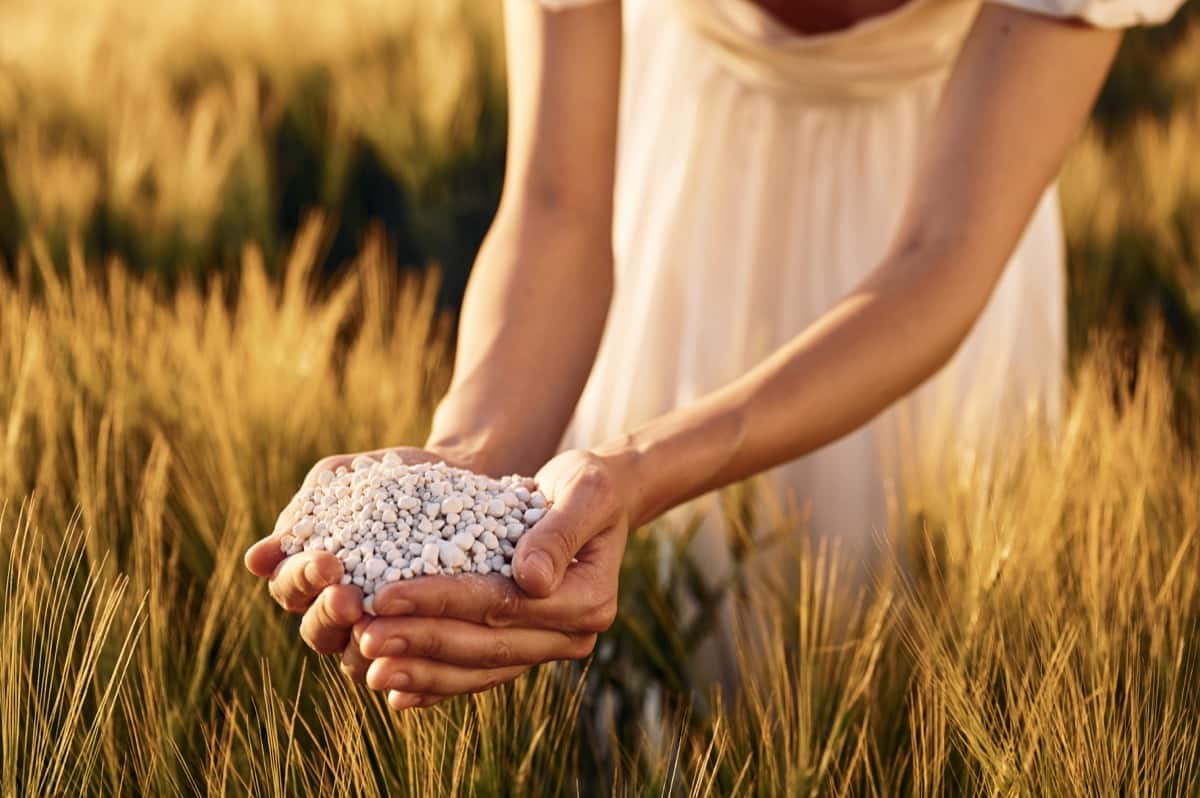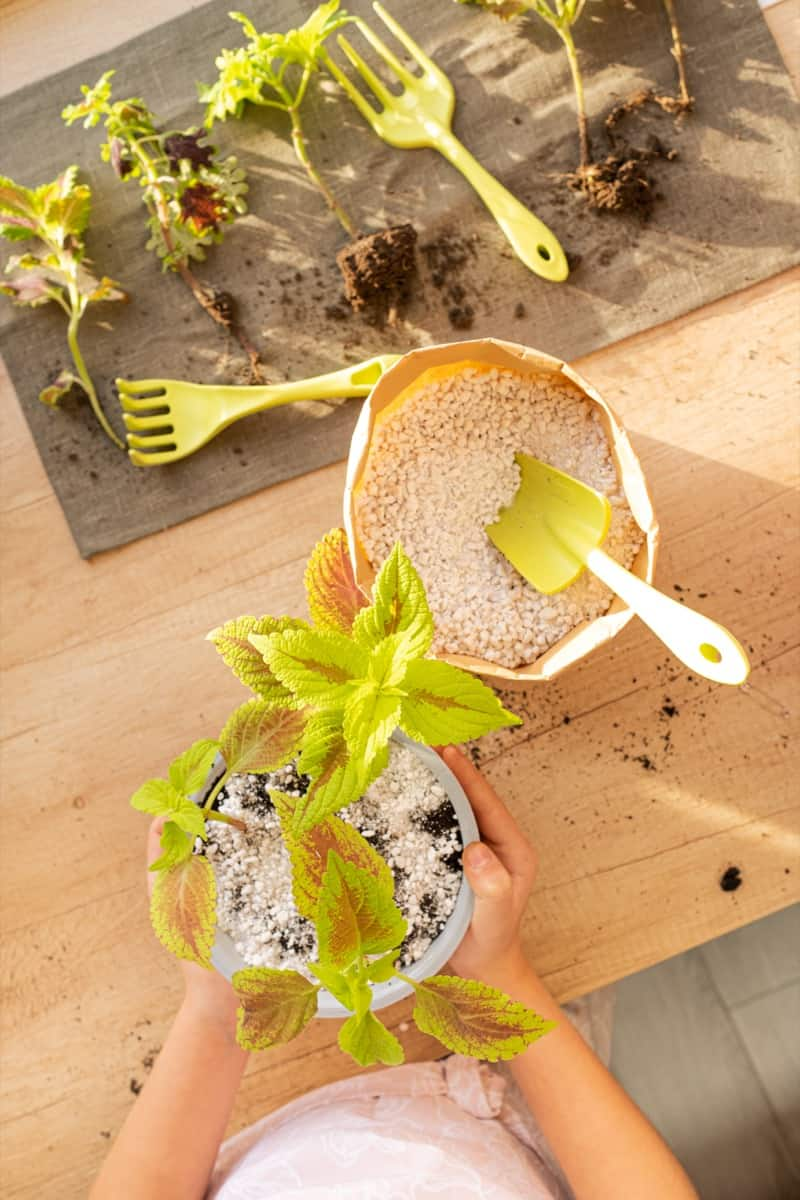Perlite is the name of a naturally occurring mineral. It exists as a type of volcanic glass created when the volcanic obsidian glass gets saturated with water over a long time. Perlite is an environmentally friendly and lightweight soil amendment often used in agriculture.

Perlite uses in Agriculture
What are the application methods for perlite?
- Broadcast application: Spread perlite over the soil’s surface and rake it into an even layer.
- Incorporation application: Pour perlite into a wheelbarrow or other container and turn it, so the powder coats the inside.
- Controlled release application: Blot perlite onto a cloth until it forms an adhesive film. Apply pressure to the film to release the powder. This method is best used for small areas.
- Plugging application: Insert plugs made of perlite into cracks in the soil surface.
When to use perlite in agriculture?
Perlite can be used in agriculture at any time of the year but is most beneficial during early spring and late fall when the soil is wetter. There are several application methods for perlite in agriculture: as a fertilizer amendment, as mulch, or as an overseeded ground cover. Perlite can be used when establishing new plants or when fertilizing existing plants. How to use perlite in agriculture depends on the type of perlite used: fresh perlite should be added directly to the soil surface; however, dried perlite can be mixed with dirt before being applied.
How to use perlite to improve soil and boost plant growth?
To use perlite in agriculture, ensure the surface you work with is clean and free of debris. Then add perlite according to the application method you are using. For example, if you use perlite for aeration purposes, add it to your soil mixture until it reaches the desired consistency. Then mix it with water to form a slurry. Use this mixture to fill planting pots or other containers. Water the plants well, then top off the perlite mixture with more water as needed.
In case you missed it: 15 Promising Sustainable Agriculture Practices: Every Farmer Should Know These

Perlite should be used when growing vegetables or fruit trees because it is not as efficient at providing insulation against cold weather during winter. When using perlite for rooting crops such as potatoes, Jerusalem artichokes, or beans, keep the soil moist but not soggy. There are several application methods for using perlite in agriculture, including as a top dressing on the surface of the soil, as a soil amendment mixed with other ingredients, or as blended into existing soils.
When to use perlite in agriculture depends on the specific situation and needs of the plants being grown. For example, perlite can be used when growing crops such as corn, wheat, or rice prone to water retention or low organic matter levels. To use perlite in agriculture, make sure it is available at your local garden or agricultural supply store. Add perlite to the desired area according to package directions. Add 2-3 cups of perlite for every 100 square feet of ground-covered application area as a top dressing on the soil’s surface.
For applications as an amendment mixed with other ingredients, add 1/2 cup of perlite for every 20 pounds of mixture ingredients. For applications blended into existing soils, start by adding 1/4 cup of perlite for every 50 pounds of soil mixture weight. Add one cubic foot of perlite for every 100 pounds of seed mix. So, for example, if you use 20 pounds of seeds, you would add 40 cubic feet of perlite to the mixture.
This will help improve moisture retention and aeration in the soil while helping reduce potential weed problems later on. Inject perlite into sandy soils to increase drainage and create conditions favorable for plant growth. For heavier soils that retain too much water, mix two parts perlite with 1 part sand or gravel to create a more stable substrate beneath plants.
How much amount of perlite to add to the soil for indoor plants?
Perlite is most commonly used in agriculture as a medium for aeration and drainage. It can be used when other media are ineffective or when larger pieces of soil are needed. When using perlite, it should be mixed with water until a slurry consistency is achieved. The amount of perlite added will depend on the type of plant being grown and the soil conditions. For most plants, 1-2 cups of perlite should be mixed into one cubic foot of soil.
Tips for applying perlite in plants
- Add perlite to the soil before planting or transplanting to improve root growth and help prevent moisture loss.
- Apply perlite as a top dress on the newly seeded ground or around plants after growing has commenced. This will help improve moisture retention and prevent erosion.
- Use perlite as an effective way to improve drainage in areas prone to flooding or landslides. Its porous structure allows water to move quickly through the material, while its lightweight nature prevents soil compaction.
- Apply perlite to the surface of plants before flowering or after harvest for added insulation and cooling effects.
- Propagate plants by dividing roots in half and placing them into perlite pots before growing.
In case you missed it: How to Balance Soil pH in Agriculture: Increase, Decrease, Control Tips, and Techniques

Benefits of using perlite in gardening
- It is an excellent soil amendment because it retains moisture and provides good drainage.
- It helps to reduce water usage in gardens and crops, as it can help to conserve moisture.
- It also helps to improve the overall appearance of plants, as it adds a layer of cushioning and provides favorable drainage.
- It can be used in place of potting soil, which makes it a more affordable option for gardeners.
- It is lightweight and easy to work with, which makes it an ideal choice for root crops and young plants.
- Finally, perlite can improve the aeration of soils, which helps plants grow stronger roots and taller trees.
Different ways to apply perlite in plants
Seed germination
- Perlite speeds up the germination process and improves seedling growth. Sow seed on a well-watered mixture of equal parts perlite and Sphagnum Moss Peat for seeds. Alternatively, add about 1 part perlite to 2 parts ready-mixed potting compost.
- Keep wet at all times by capillary irrigation. After seed sowing, sprinkle seeds with a thin layer of fine peat and cover with glass or plastic to retain moisture until germination.
- Perlite is a volcanic glass used as a potting medium, planting substrate, and aeration layer in the soil. It has improved seeds’ germination rates, especially when combined with other media such as vermiculite or perlite granules.
Rooting and cuttings
Perlite has been used as a soil amendment for over 50 years. It is high in air and water retention, making it an excellent choice for growing plants in containers or potting soil. Perlite accelerates germination, reduces the risk of damping off, provides an excellent air-water balance, and makes water ingress almost impossible. It also reduces root damage and growth retardation from grafting.
For soft stem and leaf cuttings, use a mixture of perlite and sphagnum moss peat (50/50). For harder cuttings and fragile plants, increase the perlite ratio to 4 parts perlite to 1 part peat (80/20). For mist irrigation, perlite can be used 100% where sterility is essential. Water well but ensure free drainage. Feed the plants as the roots develop.
Potting mixes
- Perlite is used in compost mixes to improve aeration, drainage and insulation. Also, perlite can be used to loosen the texture of ready-mixed loam or peat-based compost. For a soilless compost mix, use 3 or 4 parts sphagnum moss peat to 1 part perlite (80/20).
- For a loam-based compost mix, use equal parts sterile loam, peat, perlite (1:1:1), limestone, and nutrients. Alternatively, a 1:2:1 mixture can be used. Mix well, then water well and feed properly after planting.
In case you missed it: Greenhouse Farming in the Philippines: How to Start, Agriculture Crops, and Cost to Build

Soil conditioning
Perlite improves the texture of heavy silt or clay soils by increasing aeration and drainage. It also reduces the tendency to ‘cap’ on germinating seeds. These reforms will continue for many years. For difficult seed and flower beds, apply 25% perlite to the top 5-10 cm before sowing. For trees, shrubs and roses, mix perlite with soil when backfilling the planting hole to stimulate root growth.
Perlite uses in hydroponic plants
Perlite is a natural volcanic glass used in hydroponic cultivation for its high-water retention and drainage properties. This lightweight material helps to maintain the humidity levels in the air, which in turn helps to prevent disease and promote vigorous growth. Additionally, perlite retains moisture longer than other materials, which can help to sustain plants through dry periods.
Difference between perlite and vermiculite
Perlite is a lightweight and air-permeable material derived from volcanic ash. It is a popular choice for growing plants because it has high water retention and aeration properties, leading to vigorous growth and less susceptibility to root rot. On the other hand, vermiculite is a mineral that forms when magma cools below the earth’s surface.
It is denser than perlite and has better water retention and thermal insulation qualities, making it a better choice for soil amendment in cold climates. The main difference is that perlite is more heat resistant than vermiculite. This means that perlite can be used in areas with high temperatures, whereas vermiculite needs to be heated before use. Another difference is that perlite contains less water than vermiculite.
How to use perlite in the potting mix?
Perlite is a good choice for potting mix because it’s light, airy, and doesn’t retain moisture. It’s also easy to work with and has a low pH, which makes it suitable for many plants. To use perlite in your potting mix, add it to your soil mixture 1/3 of the way up the container
How to use perlite for indoor plants?
Perlite is a natural volcanic glass considered an excellent soil amendment for indoor plants. It can be used in both flower and vegetable gardens, as it provides good drainage, aeration, and moisture retention. Additionally, perlite helps to break up compaction and can help encourage root growth. To use perlite for indoor plants, make a slurry of the soil amendment and water. Then add the perlite to the mixture, mixing well until it is fully coated. Finally, allow the perlite to dry before using it in your garden or flower pot.
In case you missed it: Seaweed Extract Uses in Agriculture: A Step-By-Step Guide for Beginners

Can perlite be used as fertilizer?
Perlite is a natural product that can be used as fertilizer. It is made from volcanic glass and has been used for centuries to improve soil fertility. Perlite is an excellent material for growing plants because it is lightweight, airtight, and holds water well. It can be spread over the surface of the soil or placed in pots and containers to provide supplemental moisture and nutrients to plants.
What is perlite made of?
Perlite is a dark-colored, dense volcanic glass composed of about 70 percent silicon dioxide. Its other components include;
| Aluminum oxide | Potassium oxide |
| Calcium oxide | Sodium oxide |
| Iron oxide | Water |
| Magnesium oxide |
Different types of perlite in agriculture
- Coarse perlite has the largest particles, while fine has the smallest. The type you choose depends on how you want to use it. It is best to mix it into the soil of the garden or scatter it on top of the soil. It is also used for succulents and orchids.
- Medium Perlite is often used for potted seeds and plants. It can also be scattered over the soil.
- Fine perlite is best used for seed starting and root cuttings. Although these are scattered over the soil, wind can easily affect the fine particles.
Precautions to take while using perlite in plants
- Make sure the perlite is thoroughly prepped before use. This means removing any impurities, such as dust or dirt, that could negatively affect the material’s performance.
- Always use perlite in a well-ventilated area to avoid breathing in particles.
- Be aware that perlite can emit heat if exposed to direct sunlight or flames, so keep it away from these sources during use.
Plants grow well in perlite
Some plants grown in a container with perlite include African Violets, Begonia Xanthochlora, Bromeliads, Cactus, and Succulents.
In case you missed it: Top 15 Agriculture Software Solutions Providers in India: For Better Farm Management and Crop Yield

How is perlite made?
In its natural form, volcanic glass, or obsidian, contains a lot of water. After extraction from the earth, the material is crushed. To convert it into a lightweight material used for horticulture, natural perlite is put into industrial ovens where it is quickly heated. The water in perlite reacts like popcorn when heated. Pearlite “pops” and can expand up to 40 times its original size.
After heat conversion, perlite is light and looks like white balls. Lightweight balls are highly porous and hold their shape. They are also stable and do not decompose. At garden stores, perlite may be bagged as coarse medium or fine grade perlite. It can also be mixed into potting soil and seed starting mix.
Conclusion
Perlite can also help reduce fertilizer needs and improve organic matter retention. Perlite is a natural mineral that has been used in agriculture for centuries. It is the most important amendment used in potting soils and is also often used in greenhouses and as an air filter.
- Types of Pesticides Used in Agriculture: A Beginner’s Guide
- Economical Aquaculture: A Guide to Low-Budget Fish Farming
- 15 Common Planting Errors That Can Doom Your Fruit Trees
- How to Make Houseplants Bushy: Effective Tips and Ideas
- Innovative Strategies for Boosting Coconut Pollination and Yield
- Pollination Strategies for Maximum Pumpkin Yield
- The Complete Guide to Chicken Fattening: Strategies for Maximum Growth
- Natural Solutions for Tulip Problems: 100% Effective Remedies for Leaf and Bulb-Related Issues
- Revolutionizing Citrus Preservation: Towards a Healthier, Greener Future
- Natural Solutions for Peony Leaf and Flower Problems: 100% Effective Remedies
- Maximizing Profits with Avocado Contract Farming in India: A Comprehensive Guide
- Natural Solutions for Hydrangea Problems: 100% Effective Remedies for Leaf and Flowers
- The Ultimate Guide to Choosing the Perfect Foliage Friend: Bringing Life Indoors
- From Sunlight to Sustainability: 15 Ways to Use Solar Technology in Agriculture
- The Ultimate Guide to Dong Tao Chicken: Exploring from History to Raising
- The Eco-Friendly Makeover: How to Convert Your Unused Swimming Pool into a Fish Pond
- Mastering the Art of Delaware Chicken Farming: Essentials for Healthy Backyard Flocks
- 20 Best Homemade Fertilizers for Money Plant: DIY Recipes and Application Methods
- How to Craft a Comprehensive Free-Range Chicken Farming Business Plan
- Brighten Your Flock: Raising Easter Egger Chickens for Beauty and Bounty
- How to Optimize Your Poultry Egg Farm Business Plan with These Strategies
- Subsidy for Spirulina Cultivation: How Indian Government Schemes Encouraging Spirulina Farmers
- Ultimate Guide to Raising Dominique Chickens: Breeding, Feeding, Egg-Production, and Care
- Mastering the Art of Raising Jersey Giant Chickens: Care, Feeding, and More
- Ultimate Guide to Raising Legbar Chickens: Breeding, Farming Practices, Diet, Egg-Production
- How to Raise Welsummer Chickens: A Comprehensive Guide for Beginners
- How to Protect Indoor Plants in Winter: A Comprehensive Guide
- Ultimate Guide to Grow Bag Gardening: Tips, Tricks, and Planting Ideas for Urban Gardeners
- Guide to Lotus Cultivation: How to Propagate, Plant, Grow, Care, Cost, and Profit
- Agriculture Drone Subsidy Scheme: Government Kisan Subsidy, License, and How to Apply Online
- Ultimate Guide to Raising Araucana Chickens: Breed Profile, Farming Economics, Diet, and Care
- Bringing Hydroponics to Classroom: Importance, Benefits of Learning for School Students
- Ultimate Guide to Raising Polish Chickens: Breed Profile, Farming Economics, Diet, and Care
- Ultimate Guide to Raising Australorp Chickens: Profile, Farming Economics, Egg Production, Diet, and Care
- Silkie Chicken Farming: Raising Practices, Varieties, Egg Production, Diet, and Care
- Sussex Chicken Farming: Raising Practices, Varieties, Egg Production, Diet and Care